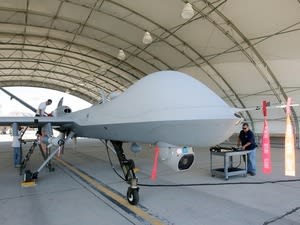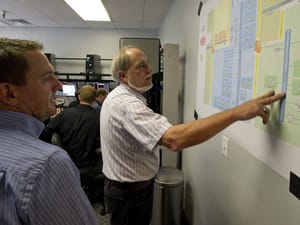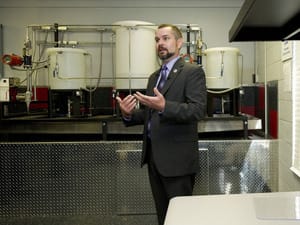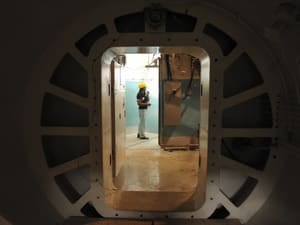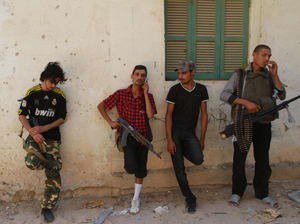Why America's Spies Struggle To Keep Up
なぜ米国の諜報組織は遅れていたのか・・
6000機にも上る高度な精密兵器の無人偵察機とその膨大な量の一次情報をエンドユーザーのための分析する作業は多くの分析官とハード・ソフトが必要となる。その総本山がコーヒーメーカで電力がダウンする。情報部隊(組織)の劣化は笑うに笑えないレベルだった。かつてCIAも含め情報を軽視した大統領は誰だったか?
by NPR Staff
January 11, 2012

Intel Wars
The Secret History of the Fight Against Terror
January 11, 2012
Before Sept. 11, 2011, there were 16 intelligence agencies in the United States. But after the attacks, the 9/11 Commission recommended creating a 17th intelligence agency — the Office of the Director of National Intelligence (ODNI) — to coordinate intelligence operations.
2011年の9月11日以前は、米国には16の情報部局が有りました。 しかし、911の攻撃以降、政府の委員会が17番目の情報部局の創設を提案しました。 それがディレクター・オブ・ナショナル・インテリジェンス(ODNI)で、情報活動の調整機能が目的の組織です。
The 16 already existing agencies didn't react well, says historian and former intelligence analyst Matthew Aid. "They hated the idea of a [so-called] 'intelligence czar,' " he tells Fresh Air's Dave Davies. "Each of the 16 intelligence agencies that existed before the creation of the ODNI [are] bureaucracies. They have a bureaucratic identity ... and they love their independence."
16の既存の情報部局はこれに十分に対応しなかったと、元情報分析官で歴史家のマッソー・エイド氏は話している。「彼らは、この「インテリジェンス・シーザー(情報の独裁者)」と呼んだ構想を嫌っていました。 ODNIが創設される以前の16の情報部局はみな官僚的になっており、それが体質化して・・・干渉されるのを相互に嫌っていました。」と彼は言う。
After much debate, the ODNI was created — but given almost no authority over the 100,000 or so spies who work for the Pentagon. The result? Essentially two separate spy networks within the intelligence community: the civilians who work for the 16 agencies reporting to the ODNI, and the 100,000 spies at the Pentagon who report to the undersecretary of defense for intelligence.
多くの議論の末、結局ODNIは創設されましたが、ペンタゴンに勤務する10万人を超える諜報部員に対する何の権限も有していませんでした。 その結果、国家の情報組織の中に二つの分離独立したスパイ組織ができました。 即ち、ODNIに報告義務を有する16の譲歩部局の私服情報局員の組織と、情報担当国防次官に報告を上げるペンタゴンの下で働く10万人の諜報部員の組織です。
"They have separate budgets, they report to separate committees, and it is a structural nightmare," says Aid. In his book Intel Wars, Aid details how overlapping jurisdictions, bureaucratic policies and a glut of data have crippled the intelligence community in its war against would-be terrorists. "You talk to officials who used to work or work today at the ODNI, and there's just frustration," he says. "I quoted one official as saying, 'It would be nice if the boys over at the Pentagon let us know what they were up to,' which I think gives a hint that says things could be more tightly controlled than they are right now."
「この二つの組織は個別の国家予算を配分され、彼らは別々の委員会に報告を上げていました。構造的な大問題です。」とエイド氏は言う。 彼の著書「情報戦争」の中で、彼は、この組織の二重構造、官僚的施策、そして大量のデータが、所謂テロとの戦いの中で、国家の情報組織を台無しにしていたかを克明に描いています。 「かつてODNIで勤務したOBや現役の職員に聞き取りをすると、まさにフラストレーションの山でした。 私はある職員の言葉を引用しました。曰く“もし、ペンタゴンの職員の連中が現状の情報を入れてくれれば、どんなに助かったか・・・” これは情報が今よりももっと、堅牢に相互に統制されて情報交換がなされていなかったということを物語っています。
Drowning In Information 情報の海に溺れて
Before Sept. 11, Aid says, the U.S. had 200 drones collecting data all over the world. That number climbed to over 6,000 after the attacks. Many of these drones provide essential information for intelligence forces, says Aid, but there's a problem: Mixed in with the good stuff is also a lot of nonessential information. Aid says intelligence analysts are drowning in the data — particularly because there aren't enough analysts to sift through what's potentially important.
9月11日以前、米国は世界中で情報データを収集する無人機を200機保有していました。 この数が911後は6000機までに増強されたのです。 これら無人機の多くは情報部隊にとって情報基盤を提供していますが、問題がありました。 それは情報が玉石混淆で、多くの不要な情報が混じっていたことです。 情報分析官は情報資料の海に溺れていました、特にどれが潜在的に重要な情報か、多くの情報をふるいにかけるに十分な分析官が不足していたのです、と彼は話す。

Matthew Aid is an intelligence historian. His work has appeared in The New York Times, National Journal and The Financial Times. マッソー・エイドは情報関連の歴史家であり、ニューヨークタイムズ、ナショナルジャーナル、フィナンシャルタイムズなどに寄稿している。
"I've interviewed a number of collectors who worked in Iraq and Afghanistan, and one of their complaints is, 'I'm sitting in a foxhole and I've got 3,000 emails coming in from Washington every morning with all the latest intelligence. And the guy said, 'It's wonderful that they're sharing this stuff with me; I just wish they were a little more selective about what they were sending me.' " Each new unarmed drone designed by the U.S. sends back even more raw data to be processed. "They're essential, but the problem is ... the amount of data is literally drowning the analyst on the order of something like 275 operators and analysts to analyze the result of each drone intelligence mission," says Aid.
「私はイラクやアフガニスタン関連で仕事をしてきた多くの情報収集担当者にインタビューをしてきました。その中での不平の一つに“私は毎朝、最近の情報に関するEメールをワシントンから3000通も受け取り、分析室に閉じこもっています。 彼等が右から左に情報を流すだけでなく負担を分担して、精査した情報を送り直してくれたらどんなに助かるか”というものでした。 それぞれ計画に従って無人機が送ってくる情報は一次資料の生情報であり、情報処理が必要なものばかりです。 “それらの情報は重要ではありますが、問題は・・・そのデータの膨大な量で、それは約275人のオペレーターと分析官を無人機の情報作戦のたびに情報資料の海に溺れさせていたのです。”」とエイド氏は語る。
And most of the drones in operation are controlled by the Pentagon, he says, so the ODNI has little control over which drones are purchased, or how the information is then analyzed. "And just so you know, the people engaged in the drone program working within the military probably [number] about 40- [to] 45,000 people ... The CIA has about 25- [to] 30,000 people," he says. "There are more people working on the drone program than [in] the CIA." Though the agencies are cooperating with each other to some degree, Aid says they're not working together as much as they should — and they're limited by what they can send out into the field.
そして、ほとんどの作戦中の無人機はペンタゴンでコントロースされています。 それゆえODNIはどのような無人機が調達され、どのように情報が分析されるのかについて殆ど関与していませんでした。 「そして、驚くことに無人機計画に従事する軍関係者は、恐らく4万~4万5千人で、・・・CIA職員は2万5千~3万人といったところです。 実に情報分析のCIAよりも無人機計画の運用(情報入手)のほうに、より多くの人が従事していたのです。 情報部局は、ある程度は相互に協力していたとはいえ、本来あるべき姿まで連携していたわけではありません。 自分達が戦場に送り込んだ無人機にからの情報に逆に縛られて手一杯になっていたのです。
"[For example] the commander of U.S. forces in Afghanistan not only controls all U.S. forces but he controls all NATO and Afghan forces, which means the U.S. intelligence community has to sanitize all of the intelligence [the commander] gets, because you don't know who's going to be reading the material," he says. "A lot of the most sensitive material collected by the U.S. intelligence community about al-Qaida ... is not cleared for dissemination to the [commander of U.S. forces in Afghanistan]. There's a separate headquarters ... where all of that sensitive stuff goes."
(例えば) アフガニスタン駐留米軍司令官は米軍だけでなく、NATO軍も指揮しており、そのため米国の情報組織は情報を指揮官のために選別しなければなりません、誰がその情報に目を通すか分らないからです。 アルカイダに関する機密度の高い多くの情報は隷下部隊に流れないようにコントロールされています。 上級指揮所は分離独立しており、高度の機密情報はそこに流れる仕組みになっています。
Technological Challenges 純粋なテクニカルな問題
Intelligence analysts are challenged not only by the glut of information coming to them through the unmanned drone program; Aid says that until recently, they also faced a more fundamental problem at the National Security Agency headquarters in Maryland: a shortage of electrical power. "The NSA was spending billions of dollars on new collection systems and vast amounts of computer hardware and software, and jamming it into its headquarters, but did not build additional power stations to keep the systems up and running," he says. "So you had these embarrassing instances ... where if you plugged in a coffee pot, you literally could knock off the electricity for an entire wing at NSA headquarters."
The solution? Every office at NSA headquarters was assigned an "electricity monitor." "If you wanted to install a new percolator coffee pot in your office, they had to measure the amps that the coffee pot generated and then write up a formal request to install the coffee pot in their office, and then go through 27 approvals before some higher-up official signed it," says Aid.
情報分析官たちは無人機から届く山のような情報に悩まされていただけでなく、つい最近まで、メリーランドの国家安全保障局(NSA)では、もっと根源的な問題に直面していたのです。 それは電力不足です。 「NSAは、新しい情報収集システムの機器やソフトに多額の予算をかけて、本部はそれらの機器で埋まっていました。しかし、彼らはそれらの機器を運用するのに必要な電力設備の建設が遅れていたのです。 ですから、少し顔が赤くなるような恥ずかしい事態も生起したのです・・・それはコーヒーポットをコンセントに差し込むと、文字通りNSA本部全体の電気回路が落ちてしまったのです。 解決策ですか? NSA本部の各オフィスに電力モニターが設置され、「もし新しいパーコレーターを自分の部屋に設置する場合は、ポットのアンペアを調べて、申請書を書き、そして最終決済を受けるまで27人の合議承認を貰うことになります。」
なぜ米国の諜報組織は遅れていたのか・・
6000機にも上る高度な精密兵器の無人偵察機とその膨大な量の一次情報をエンドユーザーのための分析する作業は多くの分析官とハード・ソフトが必要となる。その総本山がコーヒーメーカで電力がダウンする。情報部隊(組織)の劣化は笑うに笑えないレベルだった。かつてCIAも含め情報を軽視した大統領は誰だったか?
by NPR Staff
January 11, 2012

Intel Wars
The Secret History of the Fight Against Terror
January 11, 2012
Before Sept. 11, 2011, there were 16 intelligence agencies in the United States. But after the attacks, the 9/11 Commission recommended creating a 17th intelligence agency — the Office of the Director of National Intelligence (ODNI) — to coordinate intelligence operations.
2011年の9月11日以前は、米国には16の情報部局が有りました。 しかし、911の攻撃以降、政府の委員会が17番目の情報部局の創設を提案しました。 それがディレクター・オブ・ナショナル・インテリジェンス(ODNI)で、情報活動の調整機能が目的の組織です。
The 16 already existing agencies didn't react well, says historian and former intelligence analyst Matthew Aid. "They hated the idea of a [so-called] 'intelligence czar,' " he tells Fresh Air's Dave Davies. "Each of the 16 intelligence agencies that existed before the creation of the ODNI [are] bureaucracies. They have a bureaucratic identity ... and they love their independence."
16の既存の情報部局はこれに十分に対応しなかったと、元情報分析官で歴史家のマッソー・エイド氏は話している。「彼らは、この「インテリジェンス・シーザー(情報の独裁者)」と呼んだ構想を嫌っていました。 ODNIが創設される以前の16の情報部局はみな官僚的になっており、それが体質化して・・・干渉されるのを相互に嫌っていました。」と彼は言う。
After much debate, the ODNI was created — but given almost no authority over the 100,000 or so spies who work for the Pentagon. The result? Essentially two separate spy networks within the intelligence community: the civilians who work for the 16 agencies reporting to the ODNI, and the 100,000 spies at the Pentagon who report to the undersecretary of defense for intelligence.
多くの議論の末、結局ODNIは創設されましたが、ペンタゴンに勤務する10万人を超える諜報部員に対する何の権限も有していませんでした。 その結果、国家の情報組織の中に二つの分離独立したスパイ組織ができました。 即ち、ODNIに報告義務を有する16の譲歩部局の私服情報局員の組織と、情報担当国防次官に報告を上げるペンタゴンの下で働く10万人の諜報部員の組織です。
"They have separate budgets, they report to separate committees, and it is a structural nightmare," says Aid. In his book Intel Wars, Aid details how overlapping jurisdictions, bureaucratic policies and a glut of data have crippled the intelligence community in its war against would-be terrorists. "You talk to officials who used to work or work today at the ODNI, and there's just frustration," he says. "I quoted one official as saying, 'It would be nice if the boys over at the Pentagon let us know what they were up to,' which I think gives a hint that says things could be more tightly controlled than they are right now."
「この二つの組織は個別の国家予算を配分され、彼らは別々の委員会に報告を上げていました。構造的な大問題です。」とエイド氏は言う。 彼の著書「情報戦争」の中で、彼は、この組織の二重構造、官僚的施策、そして大量のデータが、所謂テロとの戦いの中で、国家の情報組織を台無しにしていたかを克明に描いています。 「かつてODNIで勤務したOBや現役の職員に聞き取りをすると、まさにフラストレーションの山でした。 私はある職員の言葉を引用しました。曰く“もし、ペンタゴンの職員の連中が現状の情報を入れてくれれば、どんなに助かったか・・・” これは情報が今よりももっと、堅牢に相互に統制されて情報交換がなされていなかったということを物語っています。
Drowning In Information 情報の海に溺れて
Before Sept. 11, Aid says, the U.S. had 200 drones collecting data all over the world. That number climbed to over 6,000 after the attacks. Many of these drones provide essential information for intelligence forces, says Aid, but there's a problem: Mixed in with the good stuff is also a lot of nonessential information. Aid says intelligence analysts are drowning in the data — particularly because there aren't enough analysts to sift through what's potentially important.
9月11日以前、米国は世界中で情報データを収集する無人機を200機保有していました。 この数が911後は6000機までに増強されたのです。 これら無人機の多くは情報部隊にとって情報基盤を提供していますが、問題がありました。 それは情報が玉石混淆で、多くの不要な情報が混じっていたことです。 情報分析官は情報資料の海に溺れていました、特にどれが潜在的に重要な情報か、多くの情報をふるいにかけるに十分な分析官が不足していたのです、と彼は話す。

Matthew Aid is an intelligence historian. His work has appeared in The New York Times, National Journal and The Financial Times. マッソー・エイドは情報関連の歴史家であり、ニューヨークタイムズ、ナショナルジャーナル、フィナンシャルタイムズなどに寄稿している。
"I've interviewed a number of collectors who worked in Iraq and Afghanistan, and one of their complaints is, 'I'm sitting in a foxhole and I've got 3,000 emails coming in from Washington every morning with all the latest intelligence. And the guy said, 'It's wonderful that they're sharing this stuff with me; I just wish they were a little more selective about what they were sending me.' " Each new unarmed drone designed by the U.S. sends back even more raw data to be processed. "They're essential, but the problem is ... the amount of data is literally drowning the analyst on the order of something like 275 operators and analysts to analyze the result of each drone intelligence mission," says Aid.
「私はイラクやアフガニスタン関連で仕事をしてきた多くの情報収集担当者にインタビューをしてきました。その中での不平の一つに“私は毎朝、最近の情報に関するEメールをワシントンから3000通も受け取り、分析室に閉じこもっています。 彼等が右から左に情報を流すだけでなく負担を分担して、精査した情報を送り直してくれたらどんなに助かるか”というものでした。 それぞれ計画に従って無人機が送ってくる情報は一次資料の生情報であり、情報処理が必要なものばかりです。 “それらの情報は重要ではありますが、問題は・・・そのデータの膨大な量で、それは約275人のオペレーターと分析官を無人機の情報作戦のたびに情報資料の海に溺れさせていたのです。”」とエイド氏は語る。
And most of the drones in operation are controlled by the Pentagon, he says, so the ODNI has little control over which drones are purchased, or how the information is then analyzed. "And just so you know, the people engaged in the drone program working within the military probably [number] about 40- [to] 45,000 people ... The CIA has about 25- [to] 30,000 people," he says. "There are more people working on the drone program than [in] the CIA." Though the agencies are cooperating with each other to some degree, Aid says they're not working together as much as they should — and they're limited by what they can send out into the field.
そして、ほとんどの作戦中の無人機はペンタゴンでコントロースされています。 それゆえODNIはどのような無人機が調達され、どのように情報が分析されるのかについて殆ど関与していませんでした。 「そして、驚くことに無人機計画に従事する軍関係者は、恐らく4万~4万5千人で、・・・CIA職員は2万5千~3万人といったところです。 実に情報分析のCIAよりも無人機計画の運用(情報入手)のほうに、より多くの人が従事していたのです。 情報部局は、ある程度は相互に協力していたとはいえ、本来あるべき姿まで連携していたわけではありません。 自分達が戦場に送り込んだ無人機にからの情報に逆に縛られて手一杯になっていたのです。
"[For example] the commander of U.S. forces in Afghanistan not only controls all U.S. forces but he controls all NATO and Afghan forces, which means the U.S. intelligence community has to sanitize all of the intelligence [the commander] gets, because you don't know who's going to be reading the material," he says. "A lot of the most sensitive material collected by the U.S. intelligence community about al-Qaida ... is not cleared for dissemination to the [commander of U.S. forces in Afghanistan]. There's a separate headquarters ... where all of that sensitive stuff goes."
(例えば) アフガニスタン駐留米軍司令官は米軍だけでなく、NATO軍も指揮しており、そのため米国の情報組織は情報を指揮官のために選別しなければなりません、誰がその情報に目を通すか分らないからです。 アルカイダに関する機密度の高い多くの情報は隷下部隊に流れないようにコントロールされています。 上級指揮所は分離独立しており、高度の機密情報はそこに流れる仕組みになっています。
Technological Challenges 純粋なテクニカルな問題
Intelligence analysts are challenged not only by the glut of information coming to them through the unmanned drone program; Aid says that until recently, they also faced a more fundamental problem at the National Security Agency headquarters in Maryland: a shortage of electrical power. "The NSA was spending billions of dollars on new collection systems and vast amounts of computer hardware and software, and jamming it into its headquarters, but did not build additional power stations to keep the systems up and running," he says. "So you had these embarrassing instances ... where if you plugged in a coffee pot, you literally could knock off the electricity for an entire wing at NSA headquarters."
The solution? Every office at NSA headquarters was assigned an "electricity monitor." "If you wanted to install a new percolator coffee pot in your office, they had to measure the amps that the coffee pot generated and then write up a formal request to install the coffee pot in their office, and then go through 27 approvals before some higher-up official signed it," says Aid.
情報分析官たちは無人機から届く山のような情報に悩まされていただけでなく、つい最近まで、メリーランドの国家安全保障局(NSA)では、もっと根源的な問題に直面していたのです。 それは電力不足です。 「NSAは、新しい情報収集システムの機器やソフトに多額の予算をかけて、本部はそれらの機器で埋まっていました。しかし、彼らはそれらの機器を運用するのに必要な電力設備の建設が遅れていたのです。 ですから、少し顔が赤くなるような恥ずかしい事態も生起したのです・・・それはコーヒーポットをコンセントに差し込むと、文字通りNSA本部全体の電気回路が落ちてしまったのです。 解決策ですか? NSA本部の各オフィスに電力モニターが設置され、「もし新しいパーコレーターを自分の部屋に設置する場合は、ポットのアンペアを調べて、申請書を書き、そして最終決済を受けるまで27人の合議承認を貰うことになります。」










